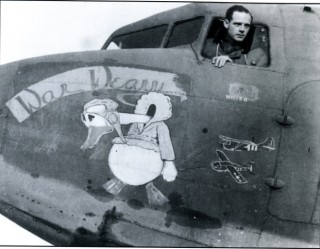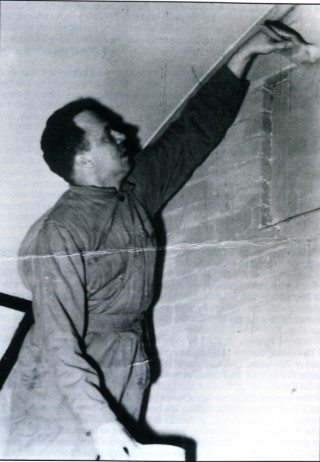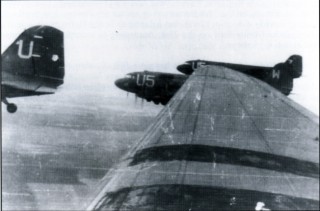Chapter 15: A Friendly Invasion
On the Wings of the Morning
Vincent Holyoak
On September 3rd 1943 U.S. Secretary of State Cordell Hull and Britain’s Viscount Halifax finally agreed that, in return for the vast amounts of arms and material Britain was receiving in war aid, additional airfields would be made available to the U.S. Army Air Force in the U.K. for its escalating campaign over Europe. As part of this process, in late 1943 ten airfields in the Grantham/Newark area were relinquished to the Troop Carrier Command of the United States Ninth Army Air Force, elements of which had begun arriving in Britain from October onwards in preparation for the coming invasion of Europe. For the allies airborne operations were still in their infancy, and in the coming months the task of the Troop Carrier Command would be to acclimatise themselves to European weather, whilst practising paratroop and supply drops, glider towing, constantly refining their tactics in the light of experience. As the RAF 5 Group bombers moved eastwards into Lincolnshire, the Group’s Headquarters in Grantham was taken over by the IXth AAF Command and the area’s ‘friendly invasion’ began in earnest.
Following U.S. custom Bottesford became ‘Station 480’. Its first unit was one of the oldest in the Ninth, the 50th Troop Carrier Wing, which had been formed in early 1941. They had transported supplies across America, Alaska and the Caribbean before moving overseas in September 1943. Now a training unit, they arrived at Cottesmore in October, and a month later received orders to move to Bottesford along with the 336th Signal Company. After the relative comfort of Cottesmore’s pre-war barracks and mess halls, Bottesford presented an entirely different picture. Nonetheless, the general opinion was that the hutted accommodation compared favourably with that found in the States. However, as winter made its presence felt this view was modified! Within a week of arrival it was Thanksgiving Day, the first in the ‘European Theater of Operations’ for most of the men, and despite the outward joviality, thoughts of home were inevitably very much to the fore. As they looked around them many of the young Americans must have wondered just what it was there was to be thankful for. A good many of them were farm boys, deliberately chosen by the Air Corps because of their familiarity with big machinery, but although they now found themselves in a rural backwater, there was nothing familiar about the environment, except maybe that it resembled ‘ … something out of a Hollywood murder mystery’.
Homesick, young and unsure of themselves, their first brushes with the locals were far from reassuring. Not only were the accents hard to understand, but far from being grateful for ‘pulling their chestnuts out of the fire’, many English people seemed aloof and resentful of their presence. There were, fortunately, a few exceptions. Bottesford’s HF transmitting station on Sewstern Lane remained in RAF hands throughout the time the Americans were there, and its operatives were a part of the small RAF ‘care and maintenance’ party under the command of Squadron Leader Pearl. AC1 Bob Williamson wrote:
We at the HF transmitting station suddenly began to live in comparative luxury. Our food supply had changed from English stodge to tinned ham, chicken, peanut butter, a great assortment of tinned fruit as well as lots of ‘cookies’, all in tins weighing about 10 lbs. We had never had it so good. Not long after the arrival of the Americans it was Thanksgiving Day, and all the RAF personnel were invited to their mess hall where we had a fantastic banquet, and after nearly four years of rationing we had nearly forgotten that such a wide variety of food existed! It was just before this that I received a call from the Entertainments Officer, who asked if I could operate movie projectors. This was a real coincidence because I’d befriended the civilian cinema manager who sometimes left me running the show whilst he popped over to the NAAFI to quench his thirst. I was told that he’d run off with the cash from the cinema and a girl from the NAAFI, and did I think I could keep the shows running? I’d receive an ex-gratia payment of £2-10s-0d a week .. ! It was usual in those days to show a travelogue before the movie, and this particular evening it was about Chicago. At the end of the show there was a knock on the projection box door and I opened it to find an American. He asked if I’d re-run the travelogue as it showed his home and the street where he lived. We waited until everyone had gone and he went back to the auditorium and watched to his heart’s content. I often wonder if he made it back.
The 50th TCW only operated a handful of aircraft itself, mostly for training or communications, although by the end of December it had on strength three twin engined C-53D Curtiss Commando transports, a small twinengined Cessna UC78 ‘Bobcat’ communications aircraft, two former RAF Percival Proctors and an Airspeed Oxford II. Also present was a single Waco CG4A assault glider. Nevertheless, the Bottesford circuit was always busy with Douglas C-47 ‘Sky train’ transports belonging to the 434th and 435th Troop Carrier Groups based at Fulbeck and Langar, and the 315th TCG from Welford Park in Berkshire. All three came under the command of the 50th TCW. Following a practice drop of the 101st Airborne Division in December, the three units spent most of their time ferrying hospitalized U.s. troops from Northern Ireland to the mainland. Three days before Christmas the 810th Medical Air Evacuation Squadron (Transport) arrived at Bottesford with its own C-47s to continue the work. These flights took place on an increasing scale, and their importance was acknowledged in February when a team of forty newsmen arrived to take part in a medical evacuation flight between Maghaberry in Northern Ireland and Pershore in Worcestershire. The subsequent article in the U.S. forces newspaper Stars and Stripes read:
Ready to Carry Invasion Wounded
With the disclosure yesterday of details of the flying hospital wards which will evacuate wounded from second front battle areas, it was revealed that the Ninth Air Force has a separate Troop Carrier Command operating in the British Isles. The first complete air evacuation group ever organized for the sale purpose of carrying wounded men is ready and waiting in England to transport thousands of Allied casualties a day from the invasion battlefields of the continent to secure hospitals in the British Isles.
On the day of the invasion there will be a large number of evacuation squadrons with the Ninth Air Force Troop Carrier Command, USSTAF officials revealed yesterday. Each squadron is comprised of 13 transport planes, each capable of carrying 18 litter patients. There is one surgeon to a flight of six planes and a nurse and enlisted surgical technicial aboard every plane.
At present 200-300 sick soldiers are being taken every week from hospitals hI Ireland to hospitals in England which have been set up to handle invasion casualties and are at present almost empty. For the air evacuation group the three planes they send to Ireland every day is routine training for the job ahead. The nurses and enlisted technicians work as a team in one of the Army’s unique enlisted/commissioned relationships. A typical team is the Jones/Marshall combination. The nurse is 2/Lt. Naomi N. Jones of Hamilton, Texas, and the surgical technician is S/Sgt George Marshall of Pittsburgh. Lt. Jones is a very pretty little girl with a cute, turned up nose, all of which belies her six years’ nursing experience. For a year after she completed her three year course she practised nursing in Texas and then, two years ago, joined the Army Nurse Corps. She is neither married nor engaged.
Marshall is a big, rough looking boy who looks as if he might have been on the Pittsburgh police force. He was. Before he joined the Army he spent eight years as a Pittsburgh cop and later, a detective. He has been married for seven years. ‘Jonesy is the best there is’ says Marshall of his diminutive working companion. ‘Jonesy’ on the other hand, claims that ‘my sergeant’ is the finest surgical technician in the group.
Military planners estimated that the invasion of Europe was going to be extremely costly in casualties. Medical care in the field was always rough and ready, so if casualties could be evacuated to hospitals in Britain, not only would their chances of survival be increased, but it would prevent the invasion bridgehead becoming clogged with wounded who might slow replacement men and equipment. This was vital if the pressure was to be maintained. With such a burden of responsibility Christmas offered few opportunities for rest or relaxation. The Wing records remarked:
Christmas Eve was but another day of duty at Wing and Maneuver Headquarters, and except for a special Christmas eve candle light communion service conducted by Major Floyd S. Smith, Wing chaplain, at 2200 hours in the base chapel, the Fiftieth marked its first Yuletide season overseas at work. Chaplain Smith arranged for Christmas Day liberty runs to Newark cathedral, allowing personnel to attend a special Christmas Day worship service, and conducted services in the station chapel for officers and men unable to make the trip. All sections functioned as on any other day.’
The reason for the heightened activity over Christmas was explained on January 7th when C-47s of the 81st Troop Carrier Squadron, 436th Troop Carrier Group began to arrive at Bottesford direct from the U.s.A. On January 1st the 436th’s ground echelon had been at Camp Shanks, New York. On the 21st they embarked on the Queen Mary and arrived at Gourock in Scotland a week later. The following day a troop train took them via Glasgow, Edinburgh, Newcastle and pulled in at Bottesford station in the early hours of the 30th where a convoy of trucks was waiting to ferry them to the airfield and a waiting meal. In comparison the air echelons had been widely spread, with – for example – the 436th’s commanding officer Lieutenant Colonel Adriel N. Williams commanding a flight at Borinquen Field, Puerto Rico. Williams’ flight’s journey to Britain involved stop-offs at Waller Field (Trinidad), Belem and Natal in Brazil, and on the night of January 6th a 1448 mile ‘hop’ across the Atlantic to Ascension Island. On the following day the flight flew 1370 miles further east to Roberts Field, Liberia. From here the next destinations were Rufisque, French West Africa and Marrakech, French West Morocco. Finally on the 18th January they set out for Prestwick in Scotland, making a wide detour out over the Atlantic to avoid German air activity. They reached Bottesford on the 21st. According to records several crews had eventful journeys:
Lieutenant Richard J. Wilson perhaps had more difficulty than any other pilot, as the trim of his ship was at all times unstable, either nose heavy or tail heavy, due to Major Herman (no middle initial) Finklestein’s rushing about in taking pictures, or his looking for his hat, his jacket, his K-rations, his face powder or his tooth brush.
Another pilot to suffer during the flight from Marrakech to St. Mawgan was Captain John F. Wallen Junior of the 81st TCS. Way out over the Atlantic he sighted a German Junkers 88 on patrol. Since the C-47s carried no armament with which to defend themselves, he ducked into the nearest available cloud. After a suitable time he emerged to find himself caught in a frantic engagement between an RAF Coastal Command Liberator and a U-Boat. The subsequent manoeuvre which, according to records he executed ‘with great efficiency’ was described as ‘Getting the Hell away!’.
Throughout February the weather was poor. Although six British Horsa gliders were issued to the 436th for evaluation only 64.55 hours were flown throughout the month, meaning that glider pilots were forced to fly as copilots on the C-47s in order to keep their hands in. This was the first time that many of the Americans had encountered the Horsa. It was a large aircraft, could carry a maximum of twenty eight troops and two pilots, and had a maximum all-up weight of 15,250 Ibs. Its huge flaps allowed it to make an extremely steep descent, something remarked upon by the pilots of the 81st TCS who found this hard to get used to. As time went by, increasing numbers of civilian carpenters were employed in modifying the Horsas to American specifications, and in assembling the CG4A Wacos which were being shipped from the States in huge wooden packing crates. Corporal Ron Shaw, now on the RAF care and maintenance party, remembered that the Americans were generous enough to donate one of the Waco packing crates to the station’s RAF cricket team. It was transported to the green at nearby Staunton Harold, used by the team to play fixtures against other RAF stations. The case was converted into a pavilion and changing room as a token of appreciation to the village for use of the pitch, and so that it could be used by local men when they returned from the war.
Because there were now four squadrons in residence in addition to the almost constant flow of aircraft from the other units, ten new ‘loop’ type hardstandings were added to the original forty ‘frying pans’ already available. The new dispersals were of a design employed by the USAAF on their heavy bomber bases and considered superior to their RAF counterparts in that aircraft could manoeuvre more easily on them. Waterlogging and low temperatures delayed construction so the problem of congestion was temporarily solved by laying sections of Pierced Steel Planking, a prefabricated track of interlocking pressed steel panels developed for use on temporary airstrips. So durable was PSP that sections can still be seen around the airfield today.
Throughout the winter, the small RAF care and maintenance party relieved the boredom by throwing itself with gusto into 5 Group sporting activities, a task in which it was fully supported by the Americans who provided transport. They were more relaxed than the RAF in this respect, and it was always possible to hitch a ride on the courier planes which left Bottesford twice daily for the south coast. The Americans seemed more informal in other ways too. A good example was the flying control officer who insisted on being called’ AI’, after the character he had played in a film with ice skating star Sonje Henje before the war. Ron Shaw saw a G.I., cigar in mouth, stop his sweeping one morning to shout across to the American Colonel coming out of headquarters, ‘Mornin’ Colonel!’. Rather than rebuke him, the Colonel merely paused long enough to remove his own cigar, growled ‘Mornin’ Son!’, put the cigar back in, and strode away; it could never have happened in the RAF!












No Comments
Add a comment about this page